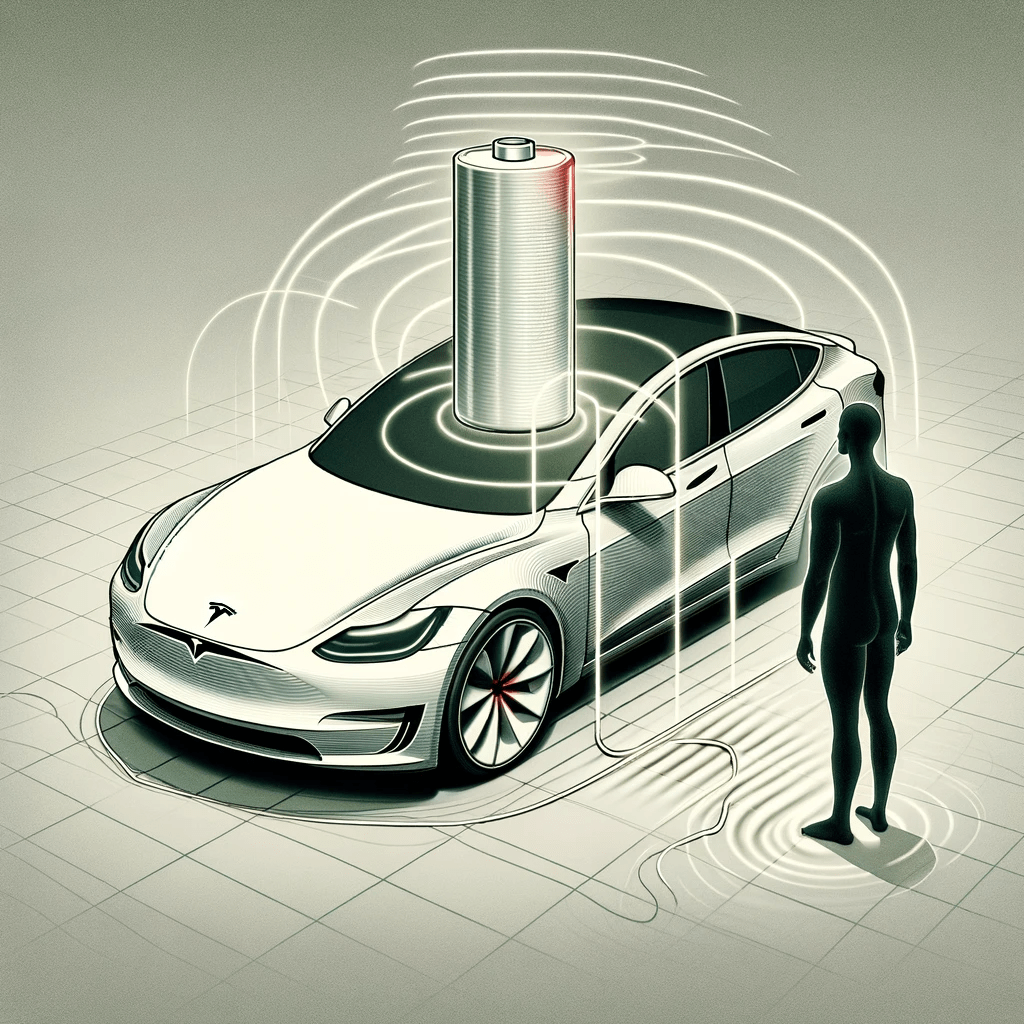Table of Contents
- Is Your Tesla A Hazard? An Exploration of the Risks of the Latest Vehicle Tech Boom
- New Tech, New Sources of EMF
- Navigating the EMF Maze: Radiation Concerns in Self-Driving Teslas
- Hidden EMF Hazards in Conventional Vehicles
- How Electric Vehicles are Generating More EMF than Standard Vehicles
- A New Frontier Presents a Need for Further Research and Regulation
- Related Posts
There’s a significant need for critical examination of the often-overlooked aspect of electromagnetic fields (EMF) and radiation (EMR) in the rapidly evolving world of electric and self-driving vehicles, particularly focusing on Tesla. This article delves into the implications of the technological shift from mechanical to electronic systems in automotive technology, raising concerns about the increased EMF exposure due to the extensive use of large battery packs and advanced technologies like GPS, radar, and lidar. It highlights the need for rigorous research and more stringent regulatory standards to address potential health risks, emphasizing the urgency of understanding the long-term effects of EMF exposure in the context of a society increasingly reliant on advanced vehicular technology. As electric vehicles (EVs) become more prevalent, the article serves as a call to action for informed decision-making and policy development in the face of the latest vehicle tech boom.
Is Your Tesla A Hazard? An Exploration of the Risks of the Latest Vehicle Tech Boom
As we embrace the future, the once-fictional ideas of fully electric, hybrid, and self-driving cars are rapidly becoming a reality. This technological revolution we’re in the midst of will no doubt change our lives and already has for many people; only time will tell whether this will be a net positive or negative, but there is certainly one potential hazard that needs to be considered amidst the rapid change – EMF and the radiation they emit.


Image Source: EMF Inspections Ltd
New Tech, New Sources of EMF
Modern civilization is in an unprecedented time; people are rapidly weaving technology into their lives to perform more and more of their daily tasks. Integration with technology, specifically electronic technology, has been a fairly normal and incremental process of growth since the beginning of the commodification of electricity in 1912, but what is different about the frontier humanity is face to face with today is such: the increase of the average person’s engagement with electrical technology has reached a tipping point beyond anything that has occurred in the past hundred or so years, thrusting us into a new boom of exponential tech growth and an extreme acceleration of adoption that is now occurring faster than the previous systems and safety measure were built to keep up with.
The Evolution of Technology and EMF Exposure
Through the various and compounding tech booms over the past hundred or so years, an increasing amount of people are catching on to the potential dangers of constant exposure to EMF, particularly now that many big names in the health and wellness industry are speaking up on the importance of personal protection and limiting daily exposure. It’s become relatively commonplace to unplug Wi-Fi routers at night, switch phones off, or put them in airplane mode when in one’s pocket, etc, but… what about cars?
What about the computers on four wheels that people climb inside every single day, often for hours at a time to commute to work, visit loved ones, and generally just get around in the modern world? Walkable cities are far from the norm and, excluding the populations of hyper-dense cities like New York, Paris, and London, people are often looked at strangely if they don’t have a car. Even in larger metropolitan areas where owning a car is less common, most people still use cars to get around via Uber, Lyft, and other ride-sharing services.
Vehicles: The Overlooked EMF Source
All of the electrical currents in all new-age tech produce magnetic fields and therefore electromagnetic radiation, which is simply par for the course of modernity. Even the average car from 2001 produces EMR from things that are now considered standard such as automatic windows, doors, locks, etc; so EMF exposure has more or less been a factor in the lives of most people today for several decades, but there is a massive difference between the EMF produced to lighting a home compared to the huge amount of power and the multitude of electrical inputs required for a completely battery-powered car to be able to drive itself from “a home in L.A., to Times Square … without the need for a single touch, including the charging,” as envisioned and partially accomplished by Tesla CEO Elon Musk.
It’s not just self-driving cars that present a potential EMF hazard; although technology is most apparent in self-driving and fully electric cars, EMF is a potential hazard in all of our vehicles as more new technology is being introduced.
Navigating the EMF Maze: Radiation Concerns in Self-Driving Teslas
Self-driving cars in general raise the most questions about EMF and the developing relationship between human health and modern vehicles, though Tesla seems to be the leader in the space so people often look to them when considering the actuality of a completely hands-free driving experience.
The Rise of Self-Driving Cars and EMF Queries
For obvious reasons, the more complex a given task, the more technology will need to be involved to accomplish the task. The GPS systems that we have become relatively familiar with over the past 20 years are certainly a source of EMF and EMR as they use radio frequency signals to communicate with satellites. Though any self-driving vehicle relies heavily on GPS to track real-time location and accurate navigation through roadways, the level of complexity required for a car to deliver a passenger without any collisions in an efficient manner has brought automotive technology to leap beyond just GPS.
Advanced Technologies and Uncharted EMF Territories
To be fully autonomous, cars require radar to constantly emit radio waves and microwave radiation to detect objects, obstacles, and other vehicles in the surrounding environment. They often use lidar (light detection and ranging) technology to essentially create a detailed 3D map of the car’s surroundings using infrared radiation and laser beams, in addition to various ultrasonic sensors and cameras.
Navigating an ever-changing landscape of traffic, inclement weather, and random road hazards requires a densely interconnected, semi-intelligent, and highly adaptive driving system beyond anything the average person will have previously experienced. These technologies in conjunction with other EMR emitting devices, ie smartphones, smart watches, bluetooth, etc, will add to the total electromagnetic field in the vehicle which is where we lack properly rigorous studies on how this may affect the human organism.
These are things people once joked about with their friends and family after watching Back to the Future 2 which creatively imagines the year 2015 – alas, the future is here.
Hidden EMF Hazards in Conventional Vehicles
Self-driving cars may be a more obvious source of exposure to EMF, but the conventional passenger-driven cars that people are most familiar with are also an ever-increasing source of EMR, as well as all other forms of modernized transportation. The further and further modern vehicles shift away from purely mechanical inputs into electrical regulation of mechanical processes, the more the web of EMF grows in size, complexity, and density.
While people may be able to easily point to GPS systems as an obvious source of EMR, more recent high-tech innovations like radar, Bluetooth, and Wi-Fi are increasingly becoming the standard in new models of consumer and commercial vehicles. Even features that may seem relatively innocuous to people, such as the automatic functionality of windows, locks, push-to-start, and seat adjustments all contribute to the total amount of EMR in modern vehicles due to the currents passed through complex and extensive electrical wiring.
Unsurprisingly, the more electronic components that are built into cars, the more electromagnetic radiation will be produced.
How Electric Vehicles are Generating More EMF than Standard Vehicles
Batteries. Massive batteries.
EVs rely on large battery packs to power their electric motors as well as entertainment, comfort, and climate control features. Unlike traditional gas-powered vehicles, where the batteries serve limited functions and are placed further away from the driver (usually in the engine bay), EV batteries are central to the vehicle’s operation.


Image Source: A ChatGPT-generated illustration depicting the electromagnetic radiation emitted by Tesla vehicles, symbolizing the potential EMF hazards associated with modern electric cars.
These battery packs are typically the heaviest component in the entire vehicle, often weighing in at 1,200 pounds or more, which requires them to be centrally located to have a center of mass that optimizes driving and safety performance. Tesla’s Model X was famously one of the first SUVs to receive a perfect safety rating due to its inability to roll over in the same way that standard SUVs with a higher center of mass are prone to – this is largely due to the huge battery pack that sits right under the passengers.
Proximity to EMF is a major factor in the concerns of potential health risks, particularly when there is an active distribution of large amounts of power (when driving and charging). Having batteries of this size and intensity located directly under the vital organs of passengers for long periods, day in and day out, is simply something humanity has never experienced on a large scale.
Automotive manufacturers are running a global live experiment, and the common person striving for a “greener solution” is the subject.
A New Frontier Presents a Need for Further Research and Regulation
The existing landscape of regulations and guidelines on Electromagnetic Field (EMF) exposure, particularly in the context of hybrid and electric vehicles, reflects a complex interplay of perspectives. While the position of organizations such as the International Commission on Non-Ionizing Radiation Protection (ICNIRP) assumes the safety of hybrid and electric vehicles, a deeper examination reveals a muddled scenario.
The ICNIRP guidelines serve as the primary industrial framework for evaluating EMF exposure levels, providing a foundation that is used for most regulatory considerations. However, as of November of 2022, more than 250 EMF scientists from over 40 nations have signed an International Scientist EMF appeal, where they are advocating for stricter regulations, emphasizing the presence of lingering uncertainties in our understanding of the potential health impacts associated with EMF exposure.
The divergence in standards and concerns becomes even more apparent when examining the lack of governmental mandates regarding measurements of electromagnetic fields and exposure within hybrid and electric vehicles. The absence of such requirements contributes to a growing lack of comprehensive studies on EMR measurements and the potential health risks associated with the emissions from these vehicles.
New frontiers often leave the responsibility to the individual to research and make informed decisions of their own volition, particularly in the obvious multitude of health epidemics of the modern world, and even more so when society is dominated by the slow-moving pace of bureaucracy, politics, and financial incentives.







